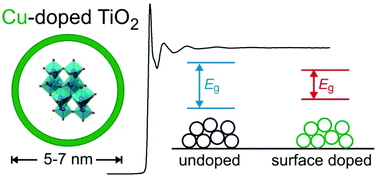Copper doped TiO2nanoparticles characterized by X-ray absorption spectroscopy, total scattering, and powder diffraction – a benchmark structure–property study†
Abstract
Metal functionalized

* Corresponding authors
a
Center for Materials Crystallography, Department of Chemistry and iNANO, DK-8000 Aarhus C, Denmark
E-mail:
bo@chem.au.dk
b MAX IV Laboratory, Lund University, SE-221 00 Lund, Sweden
c Key Laboratory for Renewable Energy, Institute of Physics, Chinese Academy of Sciences, Beijing 100190, PR China
Metal functionalized

 Please wait while we load your content...
Something went wrong. Try again?
Please wait while we load your content...
Something went wrong. Try again?
N. Lock, E. M. L. Jensen, J. Mi, A. Mamakhel, K. Norén, M. Qingbo and B. B. Iversen, Dalton Trans., 2013, 42, 9555 DOI: 10.1039/C3DT00122A
To request permission to reproduce material from this article, please go to the Copyright Clearance Center request page.
If you are an author contributing to an RSC publication, you do not need to request permission provided correct acknowledgement is given.
If you are the author of this article, you do not need to request permission to reproduce figures and diagrams provided correct acknowledgement is given. If you want to reproduce the whole article in a third-party publication (excluding your thesis/dissertation for which permission is not required) please go to the Copyright Clearance Center request page.
Read more about how to correctly acknowledge RSC content.
 Fetching data from CrossRef.
Fetching data from CrossRef.
This may take some time to load.
Loading related content
